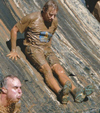There are many factors outside of the physical and physiological responses to training that we must consider when devising an exercise prescription for our athletes. There are many times, as coaches, our primary role becomes that of an advisor, mentor and protector. It’s not uncommon for coaches to have to reel their athletes in rather than push them to perform, so the question remains, when should you prioritize recovery over training?
Mood and Motivation
Two of the best indicators for readiness to train are mood and motivation. We want to ensure our athletes are excited and emotionally ready. These denominators will ebb and flow throughout a season, but it’s the job of the coach to realize when mood or motivation begins to dwindle. As such, it’s important to know your athlete on a personal level. If they are feeling uncharacteristically low on energy, simply a day or two off from training may reset motivation levels. Before embarking on a new season or a large block of training, be sure your athlete’s mood and motivation are stable and in a ready state.
Injury
Setting general guidelines on injury assessment is important in establishing a safe and healthy coach-athlete relationship. Also, knowing when to ask for help from a professional, such as a physician or physical therapist, is an important part of maintaining the health of the athlete.
It’s important to establish honest, open lines of communication with the individual. There are plenty of things you can do as a coach to maintain and even maximize performance for an injured athlete. These include strategizing time spent in the weight room by correcting muscular imbalances and identifying limiters that may impede an athlete’s potential. While the athlete is recovering, research exercises that complement their physical therapy. These serve as great a way to engage the athlete and keep them focused on recovery.
If the athlete isn’t subjected to weight-bearing restrictions, there are types of adjusted cardiorespiratory endurance activities that impose less impact. This may include hiking, fitness walks, swimming, and/or elliptical. Creating a positive, goal-orientated environment for the athlete can help their physical and emotional status throughout an injury.
Most importantly, allow the athlete’s pain to guide your flexible recovery plan.
Environment
Quite possibly, the most important barometer in knowing whether the athlete is ready to train is their environment. I like to explain it like a bucket. In life, we only have one bucket to fill. There will be times when the bucket is mostly full of training, for example, during the weeks or maybe months leading into an A-race.
But it’s essential for us to notice when the bucket is full of other things: work, family, social events etc. Let’s take the holidays for example. Holidays are oftentimes saturated with distractions, and as such, our bucket fills with things outside of training. It is important to pull back the training load to allow for other opportunities to fill our bucket. When the bucket begins to overflow, we must pull back. If not, the athlete will become overwhelmed, exhausted and lose motivation.
Introducing the Non-Negotiables
Generally speaking, athletes are highly driven, self-critical people who have an intense desire to perform and execute training to the best of their ability. This is great for racing, but this can be bad for overall health. In the case that an athlete clearly overextends himself or herself, I like to call in the ‘non-negotiables.’ These factors must be healthily attended to before an athlete takes on a heavy training program. These include nutrition, sleep, stress and movement. These play a role not only in the individual’s life but also in their readiness to train.
Nutrition
Our diet helps the body repair damaged tissue and balance energy throughout the day. If the athlete does not have a positive relationship with food or a balanced diet, many factors associated with readiness to train will be impaired.
Sleep
Sleep is the best recovery modality as it releases hormones that help the body adapt to the previous day’s training stimulus. Continually assess and reassess the athlete’s sleep habits throughout the year and season to ensure they are getting enough sleep.
Stress
Stress = stress, regardless of whether it is served up in training or from a personal source. Strive to gain insight into your athlete’s stress response, life and family responsibilities, and how they adapt to their training load. If your athlete is constantly in a high-stress environment, this will negatively affect their long-term relationship with their sport and may ripple through their work and home life.
Movement
Lastly is movement. We have to ensure the individual is ready to train. We can most easily do this by discussing current and previous injuries, taking them through a basic movement assessment and by evaluating their response to training. It’s important to have eyes on your athletes, even if you’re working with them virtually (just use your smartphone!) If you’re concerned with the athlete’s run form, bike position, posture, etc., refer them to an appropriate local specialist. Encouraging quality movement will yield quality training.
In summary, use a multidisciplinary approach when evaluating an athlete’s readiness to train. This can vary on a daily basis or throughout a season. It’s important to establish open lines of communication, have a list of non-negotiable factors the athlete must demonstrate, and have a flexible, ever-changing training program to ensure the daily and long-term health of the athlete.








